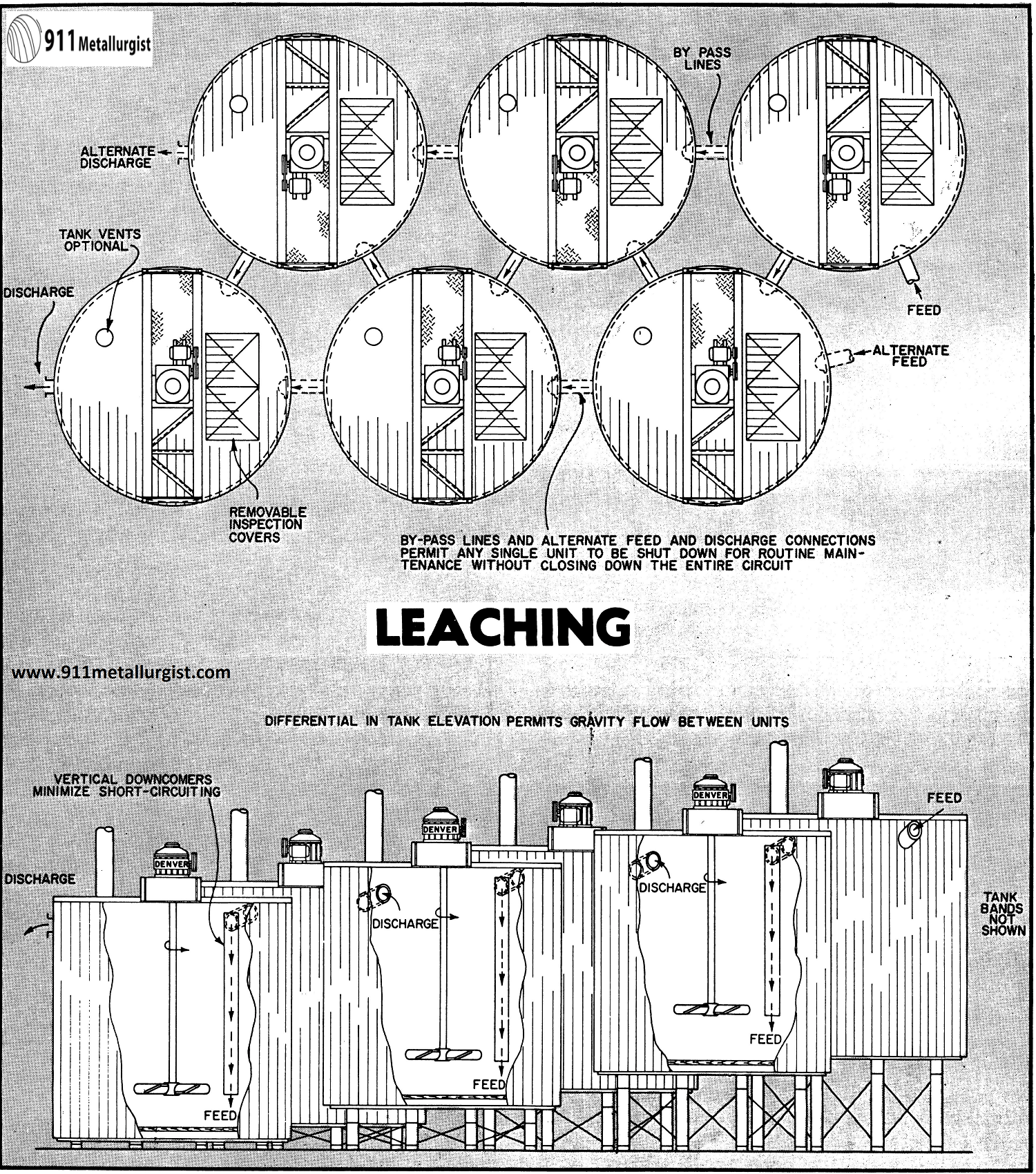Leaching plants, faced with increased tonnage, coarse (up to —3/16″ solids) feed, longer retention time, erosion, corrosion and the high cost of space, must be compact, simple and highly efficient. The engineer faced with the obvious economy of using a few large agitators compared to many smaller units must also evaluate the design factors which will prevent the settling-out of solids, provide homogeneous suspensions, lower horsepower consumption and wear.

Typical large Agitator (26′ in diameter x 30′ deep). Note tank car in background.
Modern Leaching Plant Design
For maximum space economy select the largest size leach tanks possible to minimize number of units required to provide the desired retention time. This greatly reduces the initial equipment and installation investment and subsequent maintenance costs. Three agitators in series are normally required in a circuit to eliminate possible short circuiting of pulp. It is good practice to install a fourth unit so production will not be interrupted if one agitator is down for normal maintenance or emergency repairs.
Provide relative elevation of tanks to permit gravity flow between units. The difference in elevation between tanks depends upon the fluidity of the pulp and the distance between units. Design of agitators should provide by-pass lines so any one agitator can be by-passed for maintenance without shutting down the entire circuit.
Design the feed and discharge arrangement to minimize short circuiting of the slurry. If feed is introduced at the top of the tank, discharge should be through a riser from the bottom area of the tank. An alternate arrangement involves using a down-comer to direct the feed to the bottom of the tank while the discharge is by overflow from the top. When pulp is discharged through a riser, the riser must be sized to provide gravity flow velocity. The head loss to provide gravity flow must be taken into account in determining the relative tank elevations.

Select size of agitator mechanism and propeller for low operating cost for total process economy. Initial cost is a known and fixed cost which is a relatively small factor when long range operating costs are considered.
Materials of construction for Turbine-Type Propeller and shaft should be selected for maximum wearing life to handle the abrasive, corrosive and temperature conditions involved.
Specify that leach agitators provide for simplified start-up in the event of emergency shut-down. Agitators normally can be started under full load without the delay, inconvenience or necessity of draining the tank contents or having to use air lances.
Select materials of construction for leach tanks in accordance with the service involved. Neutral slurries are usually handled in steel tanks.
Acid slurries are normally handled in wood tanks, unless the particular acid is harmful to wood. With normal plant life expectancy 4″ nominal wood staves are recommended. In cases where heat retention is important, either wood tanks or insulated steel tanks are recommended.
Where wood tanks are not applicable, steel tanks, lined with rubber, neoprene or certain fibreglass impregnated resins are used. Acid-proof brick linings are also used particularly in cases where extreme temperature and abrasion are involved.
In cases where toxic fumes are liberated in the leach operation tank covers are provided. Tank covers are sectionalized to simplify removal for servicing or replacement of propeller or propeller shaft. Fumes are vented or exhausted to waste. Where exhaust fans are required a common header usually is connected to all tanks.
Examples of typical Installations of Agitators on leaching service.

Importance of Laboratory Testing to Leaching Plant Design
Batch tests and continuous pilot plant tests can be conducted of the entire leach circuit to accurately determine the results of a full scale commercial operation.
Process efficiency is often the controlling factor of plant profits. Because of the many processes variables reliable test work to provide data in advance of plant design can eliminate much of the risk in sizing equipment which must meet definite performance objectives.
Source: This article is a reproduction of an excerpt of “In the Public Domain” documents held in 911Metallurgy Corp’s private library.
